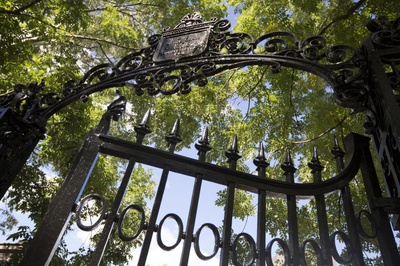
News
News Flash: Memory Shop and Anime Zakka to Open in Harvard Square

News
Harvard Researchers Develop AI-Driven Framework To Study Social Interactions, A Step Forward for Autism Research

News
Harvard Innovation Labs Announces 25 President’s Innovation Challenge Finalists

News
Graduate Student Council To Vote on Meeting Attendance Policy

News
Pop Hits and Politics: At Yardfest, Students Dance to Bedingfield and a Student Band Condemns Trump
What the Hell Happened: The AI-ification of Studio Ghibli

If imitation is the sincerest form of flattery, Japanese animator and face of the Studio Ghibli production company Hayao Miyazaki is being worshipped by a new internet trend that transforms ordinary photographs into his signature style. On March 25, OpenAI released the GPT-4o model in ChatGPT, which generates images from prompts, other images, or a combination of both. CEO Sam Altman’s X post promoting the update has since received 19,000 likes and sparked a massive social media trend of people uploading their side-by-side comparisons of themselves with their Ghibli-fied avatars.
From a technical standpoint, the images are good. It’s certainly impressive that ChatGPT can almost instantly replicate Miyazaki’s distinctive aesthetic. Large language models, or LLMs, like ChatGPT are trained on enormous datasets. ChatGPT specifically was trained on almost the entire internet, including copyrighted works like Studio Ghibli films. Consequently, when ChatGPT reconstructs a picture so it resembles a “Kiki’s Delivery Service” frame, it first consults thousands of Studio Ghibli frames in the dataset it was fed. Then it refines the data to match the prompt as accurately as possible.
But from an artistic vantage point, this trend is alarming. The copyright issues are obvious — artists have been sounding the alarm over their work being scraped by large language models since the first, cruder image generation models. What the Studio Ghibli trend specifically exposes is the danger of separating an artist and their values from their art. In 2016, Miyazaki called AI animation “an insult to life itself.” But Miyazaki’s moral aversion to AI is totally ignored by the people using the tool to create images defined by his aesthetic because of its convenience and stylistic accuracy.
The role of the artist is further debased when AI image generation is used to produce images with messages that run counter to the original artist’s legacy. For example, the official White House X account posted an AI-generated Studio Ghibli-like illustration of a woman being arrested for deportation.
It is difficult to fathom the cruelty of displaying the harsh reality of deportation using an animation style popularized by a children’s animation studio. Even the Israeli Defense Forces decided to “hop on the Studio Ghibli trend,” posting four animated images of IDF soldiers on ground, air, and sea. Many of Miyazaki’s films have anti-war themes, so using his artwork to improve the public perception of a military power is, at best, disrespectful to his life’s work, and at worst, thinly veiled propaganda.
Supporters of AI image generation may argue that it makes more art accessible, but imitation is not art. Generation tools like GPT-4o are only computer programs that have learned how to visually replicate a style. While being able to generate pictures of you and your friends in the style of your favorite childhood cartoon is certainly cute, it opens the door to more sinister uses when art is only taken at face value.
—Staff writer Khadijah A. Olufayo can be reached at khadijah.olufayo@thecrimson.com.
Want to keep up with breaking news? Subscribe to our email newsletter.
Most Read
- White House Officials Say They Sent Harvard April 11 Demands in Error, New York Times Reports
- Hour by Hour: How Harvard’s Donations Surged After Garber Challenged Trump
- As Garber Stands Against Trump, Money From Harvard Donors Pours In
- Harvard Will Fight Trump’s Demands
- No, Harvard’s Endowment Cannot Withstand Trump
From Our Advertisers

Over 300+ courses at prestigious colleges and universities in the US and UK are at your disposal.

Where you should have gotten your protein since 1998.

Serve as a proctor for Harvard Summer School (HSS) students, either in the Secondary School Program (SSP), General Program (GP), or Pre-College Program.

With an increasingly competitive Law School admissions process, it's important to understand what makes an applicant stand out.

Welcome to your one-stop gifting destination for men and women—it's like your neighborhood holiday shop, but way cooler.

HUSL seeks to create and empower a community of students who are seeking pathways into the Sports Business Industry.
